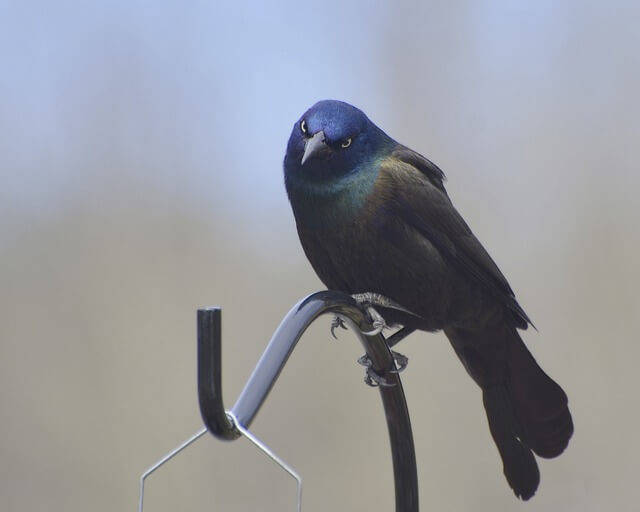Embark on a fascinating exploration of Kentucky’s diverse birding landscape with our comprehensive guide. This Ultimate Guide showcases the 58 most common birds found throughout the Bluegrass State, offering detailed insights into their habitats, behaviors, and distinctive characteristics.
Whether you’re a dedicated birder, an outdoor enthusiast, or simply curious about Kentucky’s unique birdlife, this guide provides a captivating glimpse into the avian diversity that enriches this scenic state.
Table of Contents
- 1 Most Common Birds in Kentucky
- 1.1 Northern Cardinal
- 1.2 American Robin
- 1.3 Blue Jay
- 1.4 Mourning Dove
- 1.5 Carolina Chickadee
- 1.6 Tufted Titmouse
- 1.7 American Crow
- 1.8 European Starling
- 1.9 Carolina Wren
- 1.10 American Goldfinch
- 1.11 Red-bellied Woodpecker
- 1.12 Downy Woodpecker
- 1.13 Song Sparrow
- 1.14 White-breasted Nuthatch
- 1.15 Red-winged Blackbird
- 1.16 Common Grackle
- 1.17 House Finch
- 1.18 Northern Mockingbird
- 1.19 Eastern Bluebird
- 1.20 Eastern Towhee
- 2 Frequently Asked Questions
- 3 Author
Most Common Birds in Kentucky
Northern Cardinal
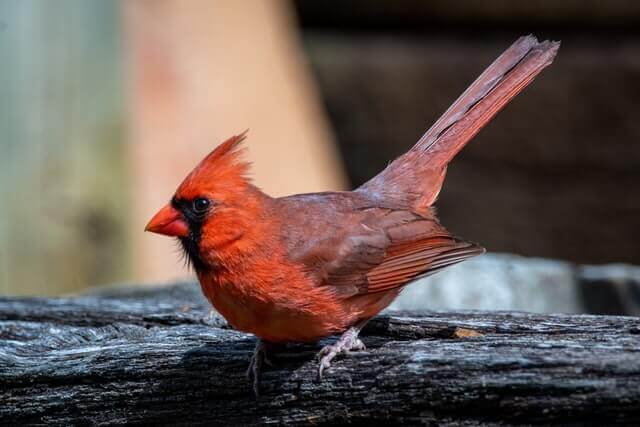
The Northern Cardinal is native to North America, from the states of Kentucky, Ohio, Illinois, Michigan, Wisconsin, Minnesota, Iowa, and Arkansas, but they have also been recorded from Quebec, Ontario, New Brunswick, Nova Scotia, Quebec, and farther south to Texas and Louisiana.
In the fall the male will follow the winter migration route south and the female will follow the same route in the spring. This is a long-distance migrating bird that visit the southern states each year, but returns each winter as well. They return to their various winter destinations as the first part of a long flight back south through the Georgia and Tennessee mountains.
One of the favorite places for the nesting behavior of the northern cardinals is at the bases of large pines or trees in the backyard bird feeders. When they build their nests near or under trees, they are protected from cold winds and from being eaten by hungry animals.
- Frequency: 65.15% (Statistic: eBird)
- Color: Mostly red with a black mask on the face, short pink bill
- Habitat: woodlands, gardens, parks, backyards, and wetlands
- Range: USA, Canada, Mexico
- Size: 8.2 – 9.3″ inches
- Weight: 33 – 65 grams
- Diet: Fruits, berries, and insects (grasshoppers, beetles, snails, cicadas)
- Family: Cardinalidae
- Genus: Cardinalis
- Maps: Range Map – Sightings Map
- Sounds: Calls and Songs
Related Posts:
American Robin
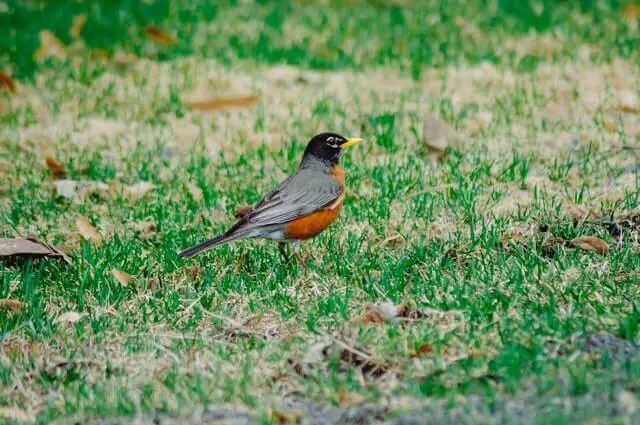
The American robins are a very common migratory songbird among the thrush families, also of the family Turdidae, which is the most common robin in the North America, from which it is sometimes referred to as the winter robin. The American Robins migrate to southern Canada and the northern United States in the early spring, flying south until they reach the Gulf of Mexico and down to southern Texas in the spring.
They return north through Mexico and into the United States. There they overwinter through the summer in shelters and caves. In the early spring, they form flocks and fly east-west over the Gulf of Mexico and the Atlantic along the southern coast.
In the fall and winter, some of these birds become shy and migratory. For that reason, they may not be seen around nesting areas until late in the season or even early in the spring
- Frequency: 51.76%
- Color: Mostly brown on the back with an orange colored breast
- Habitat: Wooded areas, backyards, parks, fields
- Range: USA, Canada, Mexico
- Size: 12 – 16″ inches
- Weight: 72 – 95 grams
- Diet: Fruits, berries and insects (earthworms, beetles, caterpillars
- Family: Turdidae
- Genus: Turdus
Related Post: Interesting American Robin Fun Facts
Blue Jay
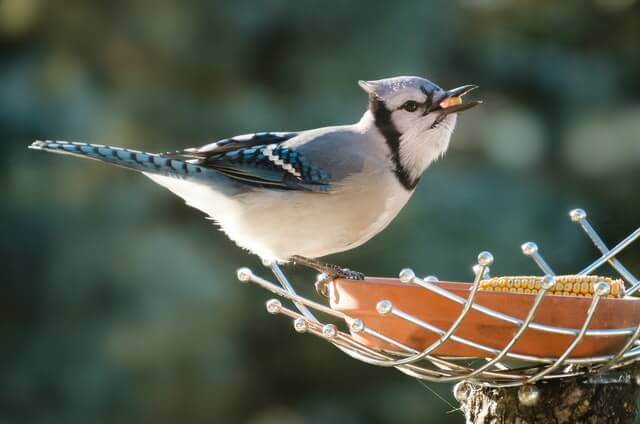
The Blue Jay is uncommon passerine, that is a member of the Corvidae family, native to central and eastern North America. It’s common to find these throughout the United States and in some parts of Europe.
It’s probably most familiar as a winter visitor, but the common birds arrive in the spring, usually in flocks, and migrate back north during the fall. Blue jays prefer dry, warm sites to call their nest, so feeders should be located at intervals that coincide with times when they’re likely to be out feeding.
This will ensure that they can feed without running into trouble while trying to find a place to shelter. Blue jays are common bird feeder visitors because of their small size and beautiful plumage. A dish with water placed by a perch will attract these birds. These birds have simple tastes and prefer peanuts, andsuet.
- Frequency: 49.81%
- Color: Blue crest on the head, wings, back, and tail, and has a white face and belly
- Habitat: Deciduous and mixed forests, mixed woodlands, backyards, parks
- Range: Southern Canada, Eastern and Central United States, Florida and Texas
- Size: 8 – 12″ inches
- Weight: 70 – 100 grams
- Diet: Nuts, seeds, caterpillars, grasshoppers, and beetles
- Family: Corvidae
- Genus: Cyanocitta
Related Posts:
- How to Attract Blue Jays to your Yard?
- Do Blue Jays Migrate? The Truth
- What do Blue Jay Eat – All The Facts
Mourning Dove
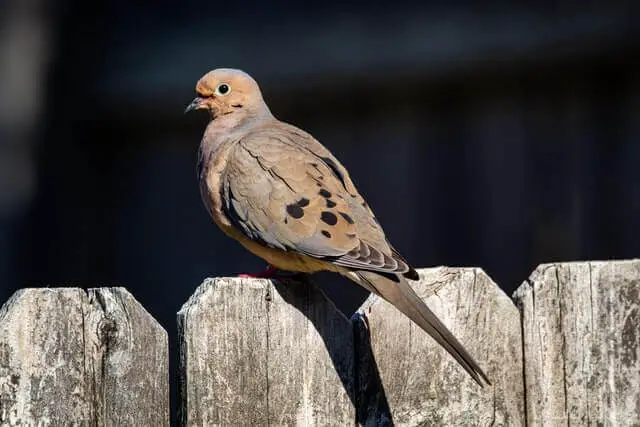
The Mourning Dove is a beautiful member of the dove’s family, Columbidae. The species is also referred to as the Carolina dove, or the rain dove, as well as colloquially as simply the turtle dove. Like most other doves, it is hovering species which breeds in the lakes and rivers of what is now known as Eastern North America.
It is perhaps most well-known as a nesting bird with its distinctive song.This species often nest on or near bodies of water, particularly creeks and rivers. Mourning Dove generally enjoy warm southern weather. They enjoy food sources in fields and around water, especially in areas where they can feed.
As we have mentioned, however, they tend to migrate and should always be located near food sources. There are some areas in the southeast that offer excellent bird watching opportunities, in fact, you may find that there is an abundance of these birds in the area, especially in areas with thick trees and lots of shelter from rain or storms.
- Frequency: 49.36%
- Color: Light gray-brown and lighter and pinkish below. The wings have black spots.
- Habitat: Open habitats, urban areas, farms, prairie, grassland, wooded area
- Range: USA, Canada, Mexico, Central America, Greater Antilles
- Size: 12″ inches length
- Weight: 112 – 170 grams
- Diet: Rapeseed, corn, millet, safflower, sunflower seeds, pokeberry, sesame, and wheat.
- Family: Columbidae
- Genus: Zenaida
Carolina Chickadee
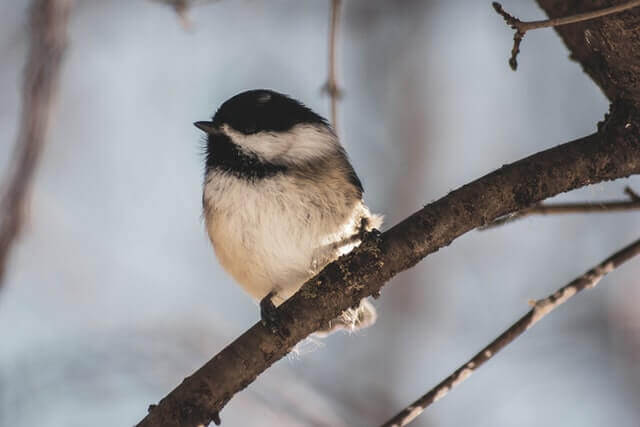
The Carolina Chickadee is extremely little known passerine in the larger tit family Paridae.They are browsers, although they are not necessarily ground-dwellers.
Most Carolina Chickadee hatchlings are born in late summer and early fall and feed on the foliage of overhanging trees and bushes before emerging into the underbrush to begin the long migration back to the warmer regions of the southern United States and Canada.
The Carolina Chickadee feeds mostly on insects. They eat berries, seeds, leaf buds, nuts, and other woody vegetation in abundance. They also are seasonal feeders who feed in different areas in the spring and summer migrate back to the same locations in the fall, and again feed in the spring and summer. In fact, the Carolina Chickadee does not even migrate; it is found in its natural habitat year round.
- Frequency: 46.98%
- Color: Black cap and throat with white cheeks. Light gray wings, back, and tail.
- Habitat: Deciduous forests, suburbs, parks, backyards
- Range: USA ( Texas, Florida, New Jersey, and Kansas)
- Size: 4.5 – 5.1″ inches long
- Weight: 9 – 12 grams
- Diet: Insects, berries, seeds
- Family: Paridae
- Genus: Poecile
Tufted Titmouse
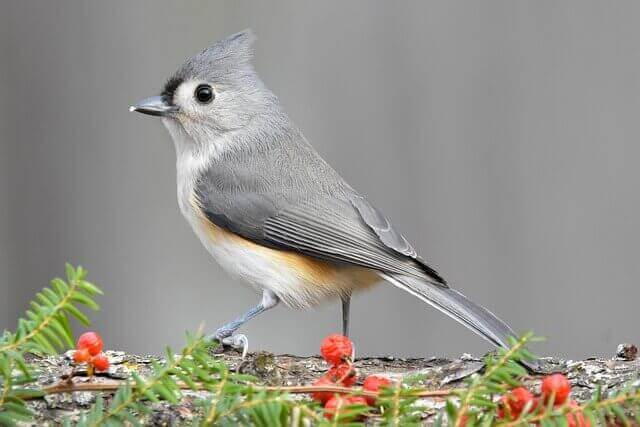
The tufted titmouse has become a fairly common in the United States, especially in the southern states. This small, mid-sized bird varies in size from about 5.5 inches to about 6.3 inches. The tufted titmouse is actually a member of the chickadees and titmice families but is smaller than the average chickadee or titmouse.
The tufted titmouse usually mates for life, laying one or two eggs in late summer and early fall. The male does not fly and instead preys on smaller birds of prey such as quail, willow, and siskins.Tufted Titmice is common nesting birds in most deciduous woodlands. They may be observed nesting on roads, roof tops, and other structures such as birdhouses.
Tufted Titmice are frequent visitors to birdfeeders and birdbaths and are frequently observed roosting high in trees, often on bird feeders or bird baths. The tufted titmouse also feeds near bird baths and sits on bird feeders or on bird feeder stands. When disturbed, they usually return to its nest quickly.
- Frequency: 43.42%
- Color: Gray upper, white front, a tufted gray crest on the head
- Habitat: Deciduous forests, river basin, backyards, swamps
- Range: Canada, USA, and Mexico
- Size: 5.5 – 6.4″ inches
- Weight: 18 – 26 grams
- Diet: Nuts, insects, berries, seeds small fruit, and snails
- Family: Paridae
- Genus: Baeolophus
Related Post: How to Attract Tufted Titmouse to my Yard
American Crow
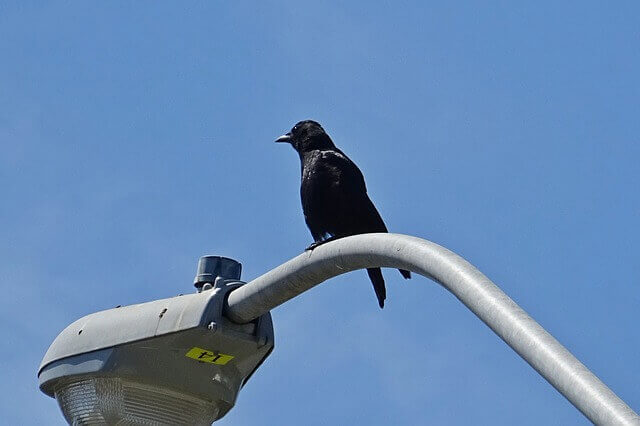
The American Crow is a large passerine of the genus Corvidae, of the crow family. It is an extremely common, usually found across much of North America.Although the American crow has a widespread distribution across most of its range, especially across the central United States and into northern Mexico.
Compared to other Corvidae, the American crow has relatively high activity levels and a rapid life cycle. During the spring, male crows fly thousands of miles from breeding sites to find mates. A pair of adult male crows incubate the eggs for up to nine months. During that time they forage heavily, traveling up to three hundred kilometers every day.
In the fall and winter, American crows make short flights home. They nest in open areas, especially around water. When it’s warm enough, they’ll nest near plants where they can look over the water and spot food. If you see a rookery or any building with several boxes, those are the best places to start looking.
- Frequency: 43.31%
- Color: Black
- Habitat: Open country, farms, parks, woodlands, towns, cities
- Range: Canada, USA, Mexico
- Size: 16 – 21″ inches
- Weight: 315 -620 grams
- Diet: invertebrates, carrion, seeds, eggs fish, grains, mice, frogs, and other small animals.
- Family: Corvidae
- Genus: Corvis
European Starling
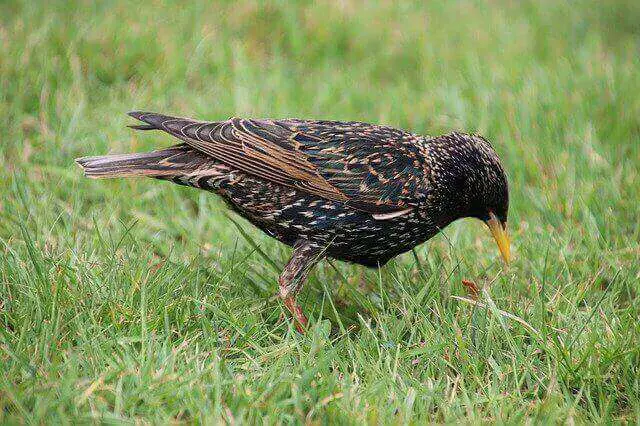
The European starling, in the starling’s family, Sturnidae, with an average size of up to 8 inches. It is mostly found in urban areas where there are a large number of buildings and open areas.
Because it breeds mostly in northern America, and because of the vast numbers who pass through the area annually, it has become an icon of the avian world. The European Starling can frequently be seen in gardens and backyards in North America.
These birds are extremely popular with ornithologists and nature lovers, and the European Starling is especially popular. In recent years, however, there have been concerns over the growing population of starling in parks and other public areas in North America and Europe.
- Frequency: 40.66%
- Color: Black with glossy iridescence plumage
- Habitat: Forests, woodlands, backyards, edges, yards, and parks
- Range: North America, Europe, Africa, India, Middle East, China
- Size: 7 – 9″ inches long
- Weight: 60 – 100 grams
- Diet: Insects (ants, beetles, invertebrates), fruits, seeds, berries
- Family: Sturnidae
- Genus: Sturnus
Carolina Wren

The Carolina wren is extremely common species which is currently a regular resident in both the eastern portion of the united states of America and, usually, the far south of Ontario, Canada. This small and beautiful bird spends most of its life in large schools or flocks. In the southern states, where the Carolina wrens occur in great numbers.
The Carolina wren eats mainly berries, seeds, insects, worms, and small animals. It also scavenges around garbage in search of carrion. This bird is an aggressive bird, which has been reported to destroy houses and even gardens as it roosts high in trees.
In the winter, the wrens will take cover under large leaves. During the long and harsh winters, you may see them forage around your porch, window sill, or any other area outside. Their unique features make them easy to spot. During spring, a female wren will dive into the branches of a nearby tree to deposit eggs.
- Frequency: 39.97%
- Color: Black cap and throat with white cheeks. Light gray wings, back, and tail.
- Habitat: Deciduous forests, suburbs, parks, backyards
- Range: USA ( Texas, Florida, New Jersey, and Kansas)
- Size: 4.5 – 5.1″ inches long
- Weight: 9 – 12 grams
- Diet: Insects, berries, seeds
- Family: Paridae
- Genus: Poecile
American Goldfinch
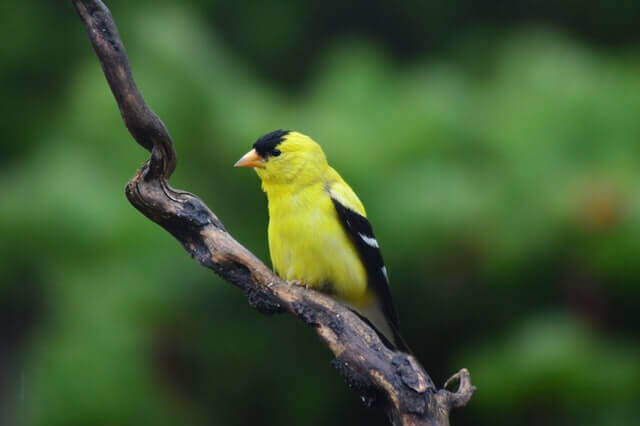
The American goldfinch (Spinus tristis) is a very common and beautiful little North American bird, from the finch family. It is regularly diurnal, ranging from late-spring to early-summer in its range, and from nearly mid-ontogenetically to migratory during the nonbreeding season. The birds are also semi migratory, moving southward and northward every year.
Goldfinches are commonly found in North America and in Central and South America. The most common time to see these birds is from late spring through early summer, when they return to their wintering grounds. During this time, they prefer to bird feeders that are placed in shaded areas.
This is because they like to roost under cover, where they can avoid the harsh rays of the sun and the strong winds.One issue to consider is goldfinch have a tendency to nest near or in abandoned buildings, such as houses and barns. Goldfinches can also be attracted to birdhouses and nesting boxes.
- Frequency: 39.28%
- Color: Face, neck, and underside are yellow, black wings with white bars
- Habitat: Deciduous forests and thickets, roadside, grasslands, backyards, meadows
- Range: Canada, USA and Mexico
- Size: 4.3 – 5.5″ inches length
- Weight: 12 -18 grams
- Diet: Grass, dandelions, chickweed, sunflowers and ragweed, thistle, red alder, birch, spruce seeds
- Family: Carduelinae
- Genus: Spinus
Related Post: American Goldfinch Interesting Facts
Red-bellied Woodpecker
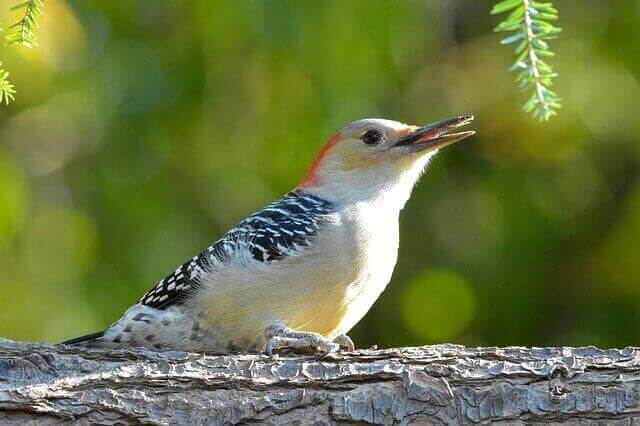
The red-bellied woodpecker, also known as the southern woodpecker, is a medium-size woodpecker of the genus Picidae of North America. It breeds primarily in the eastern part of the US, mostly between the Mississippi and Canadian Border, ranging eastward to Texas and as far west as Minnesota and Oregon. The red-bellied woodpecker prefers low trees near creeks and rivers in which to breed; trees that provide sheltered areas for nesting and roosting.
The red-bellied woodpecker uses its bill for chiselling into trees, and is able to use it’s long tongue to pull insects and beetles from the tree bark. They will nest near birdhouses or anywhere there is an adequate supply of food and cover. The male nests in trees in spring but returns to the bird feeders in late summer.
The Red-bellied woodpeckers will do well in suburban and rural areas. Their deciduous branches provide plenty of protection for them in their natural habitat. They also enjoy trees with deciduous branches near their feeders. But wherever you find these birds you should make sure they have sufficient cover apart from any trees or bushes.
- Frequency: 38.73%
- Color: Gray on body and face and underparts. Black and white pattern on wings, back, and tail.
- Habitat: Forests, backyards
- Range: Southern Canada, Eastern United States, Florida
- Size: 9 – 10.6″ inches long
- Weight: 56 -91 grams
- Diet: Insects, tree frogs, eggs of small birds, oozing sap, and small fish.
- Family: Picidae
- Genus: Melanerpes
Downy Woodpecker

Commonly seen at winter feeders as well as winter suet feeders, Downy Woodpeckers is a year-round resident in Kentucky and in all their range. Downy Woodpeckers easily holds the record of being the smallest and most common American woodpecker. Although nocturnal, they have been seen in the daytime foraging on wooded areas near feeders. It is not uncommon to see the birds in birdhouses during the day.
The reproductive profile of the Downy Woodpecker is unique. Unlike most North American birds, it has a long season for breeding. During July and August the birds migrate southward and after that they reproduce all the year round.In North America, Downy Woodpeckers is most commonly seen from late winter through early spring, at which time they will be readily seen flushing down the trails in search of food and nesting.
They have also become somewhat scarce around May. While the bird’s annual migration route changes, they typically return to their territory between late winter and early spring.
- Frequency: 36.88%
- Color: Black with a white throat, belly, and back. White spots on wings
- Habitat: Deciduous forests and thickets, roadside, grasslands, backyards, parks
- Range: Canada, USA, and Mexico
- Size: 5.5 – 7.1″ inches in length
- Weight: 20 – 33 grams
- Diet: Mostly insects and beetles and ants, also gall wasps, caterpillars
- Family: Picadae
- Genus: Dryobates
Song Sparrow
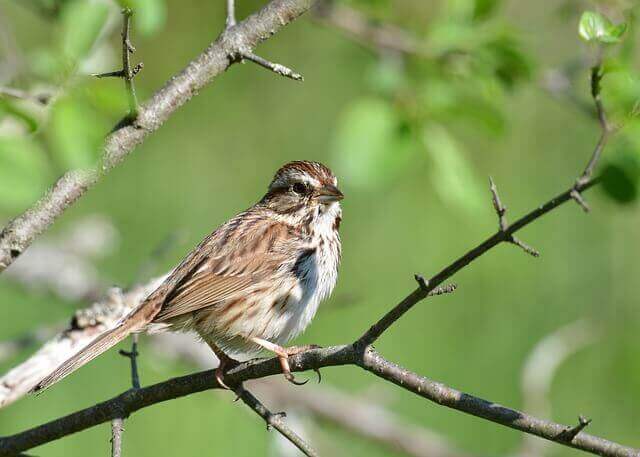
The song Sparrow is a medium-sized New World sparrow. The song sparrow also has some unique adaptations to its lifestyle and diet. Unlike other, less elaborate, birds, the Song Sparrow has a thick beak which it uses to scrape algae off exposed rocks or underwater surfaces, which it partially tears apart to get to food.
Once a Song Sparrow has learned to nest in a tree, it will usually wait there until the other birds leave or before nesting itself. Then it will begin to build a nest in either an upturned, twiggy tree branch a cavity in a root canal, or inside a small crevice in a rock or stone.
It will also take advantage of nearby buildings and cavities, such as holes in concrete steps or bird houses, bird feeders, bird boxes, and bird houses. The female will often build a nest near or next to a water source, such as a birdbath. In areas where there are a great many sparrows, the Song Sparrows will take advantage of bird baths by building their nests right in the middle of these baths.
- Frequency: 34.16%
- Color: Gray head, white cheek, a black bib, rufous neck
- Habitat: Urban centers, farms, backyards, edges, yards, and parks
- Range: Europe, Mediterranean, Asia, Australasia, Africa, and the Americas
- Size: 5.5 – 7.0″ inches
- Weight: 25 – 40 grams
- Diet: Grains, seeds, and insects
- Family: Passeridea
- Genus: Passer
Related Post: How to Attract Sparrows to your Backyard
White-breasted Nuthatch
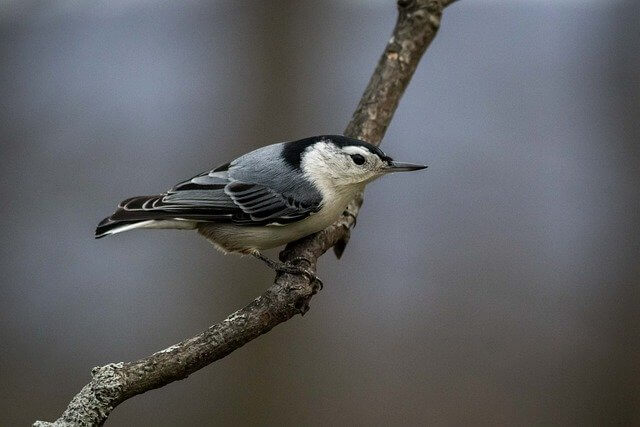
The white-breasted nuthatch is a small, stocky songbird native to northern temperate North America. The nuthatches are primarily nocturnal and feed on a variety of insects. Both the male and female may be found in flight around late spring or early summer, when the birds are migrating from southern states to northern areas.
These birds are frequent visitors to bird feeders and bird baths, they are reported to prefer garden vegetables and fruits over other plants, while insects such as aphids, mites, spider mites, leafhoppers, ticks. White-breasted nuthatches are typically found in northern deciduous habitats, which are characterized by trees with deciduous foliage. These include sycamore, oak, ash, maple, fir, Douglas fir, hickory, and pine.
In the central to southwestern United States, they can be found in California, Colorado, New Mexico, Arizona, Texas, Kentucky, Iowa, Illinois, Minnesota, and part of Nebraska. They are also commonly found in deciduous forests in northwest North America. These birds are extremely common in coniferous forests of the Pacific Northwest, central, northern California, and the central California mountain ranges.
- Frequency: 26.83%
- Color: Has a white face, flanks, and chest. It has a black cap on its head a bluish-gray upper and a brown belly
- Habitat: Deciduous forests, conifers, roadside, rivers, backyards, parks
- Range: Southern Canada, USA
- Size: 5.9″ inches
- Weight: 20 grams
- Diet: Acorn nuts, hickory nuts, ants, caterpillars, scale insects, pine weevils
- Family: Sittidae
- Genus: Sitta
Related Post: How to Attract Nuthatches to your Backyard
Red-winged Blackbird
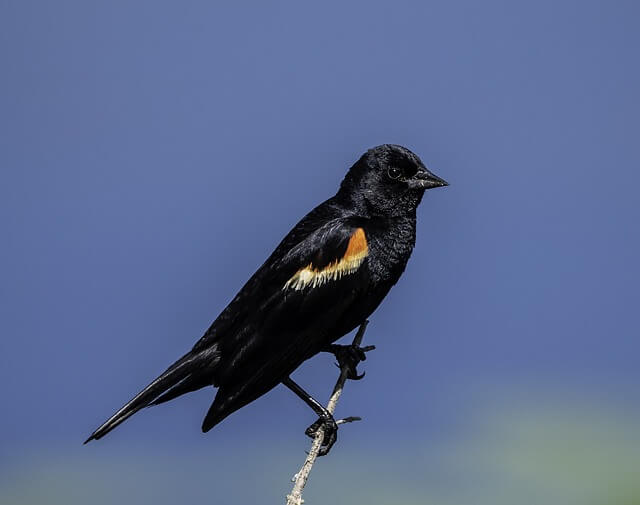
The red-winged blackbird, is a very common in the eastern United States, especially along the coasts and in forests. The life cycle of the red-winged blackbird has a very irregular pattern, beginning with a long migration south of its native range, then moving east across the continent to the central mountains of Mexico.
The birds’ migratory paths may overlap each other, resulting in a single pair or a number of pairs emerging from different locations in North America, then flying back south for the winter. The same type of cycle occurs between the spring and fall seasons. The Red-winged Blackbird returns to its native area in the summer to mate and raise young.
The life cycle of red-winged blackbirds males and females is quite different. When they are not migrating, they spend much of their time on the ground, searching for food and other sources of entertainment. They are not noisy creatures but rather serene and quiet. Their mating calls are distinctive, slightly raspy, and seem to be very reminiscent of the song of the woodpecker.
- Frequency: 26.01%
- Color: All black with red patches on shoulder and a yellow wing bar
- Habitat: Deciduous forests, conifers, roadside, rivers, backyards, parks
- Range: North America, Central America
- Size: 6.7 – 7.1″ inches length
- Weight: 41.5 – 65 grams
- Diet: Seeds and insects (butterflies, dragonflies, moths, frogs, worms, spider, snails, carrion, flies.)
- Family: Icteridae
- Genus: Agelaius
Common Grackle
The common grackle, is a medium-sized icicle found in numbers through much of North America. First identified in 17 1958 by Carl Linnaeus, the common grackle has since then been described in a number of different subspecies.
Most common grackle occur in the country in dry and open areas. Many times they nest in small caves or burrows that have been dug from the ground. Other times they may nest in old logs that have been cut down to accommodate a grove of trees where the bird may raise its offspring in return for a shelter.
he most dramatic seasonal occurrence of the common grackle occurs in the fall when they flock to large shrubs and trees to prepare for their annual migration to warmer climates.
- Frequency: 24.72%
- Color: Black overall with a blue, and purple iridescence. Its body plumage is a shimmering copper color.
- Habitat: Woodlands, marshes, meadows, parks, backyards, and fields
- Range: East of the Canadian Rockies, Canada and the United States
- Size: 11 – 13″ inches length
- Weight: 75 – 143 grams
- Diet: minnows, eggs, berries, seeds, grain, insects, frogs, mice
- Family: Icteridae
- Genus: Quiscalus
House Finch

The beautiful house finch is a species of the common finch family, Fringillidae. It is indigenous to the western portion of the United States and now is widely introduced to the eastern side of the country and, specifically, Hawaii. In the fall, the female House Finch returns north across north America. The male returns south across Midwest. During spring, the two birds meet in the western corner of the lake Michigan and then spend the winter there.
The male returns north again in May and again in June. The birds’ annual migration takes them up and down the Great Lakes, over the Appalachian mountains, and into Canada and Alaska.During July and August, the birds return to their breeding sites. A birdwatcher’s paradise, these sites include the rocky areas along a river and stream, the wetland areas of a marsh and field, or the dry dankness of a forest.
House Finch has special feeding and nesting areas in various areas throughout the park. The birds are highly selective about what plants they eat. Herbaceous plants, such as wheat and corn, along with nastily aromatic weeds, such as blueberries, are favored.
- Frequency: 24.23%
- Color: Reddish face and upper breast, brown streaks on back, belly, and tail.
- Habitat: urban and suburban areas, backyards, edges, yards, and parks
- Range: Canada, USA, Mexico
- Size: 5 – 6″ inches
- Weight: 16 – 27 grams
- Diet: Aphids, grains, seeds, berries, nettle, dandelion, sunflower
- Family: Fringillidae
- Genus: Haemorhous
Related Post: How to Attract House Finch to Your Yard?
Northern Mockingbird
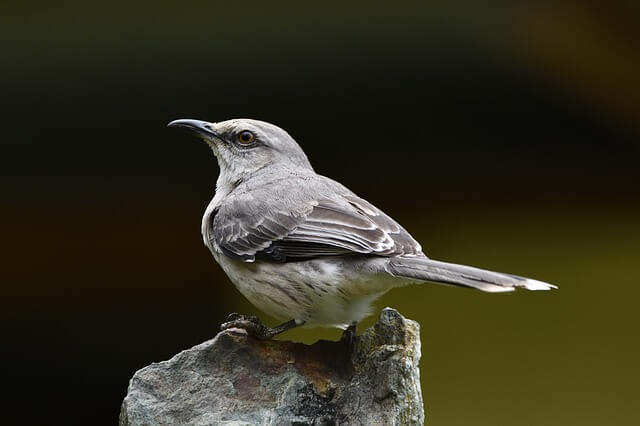
The northern mockingbird is the only mockingbird found in North America. The life cycle of these birds has not changed much over the years. They nest in areas that are away from other birds or plants. They may even nest in trees, so you need to be careful when you go into your garden to take note of where they are. Sometimes it may even be possible to find them nesting in your own roof, attic, or garage.
The northern mockingbird is primarily a winter visitor but occasionally will move south for the winter. While they are extremely social birds with flocks of up to fifty members in flight, they are nocturnal birds and feed at night.
They tend to eat left over roosting foods that include worms, grubs, grasshoppers, ants, and other insects during late spring through early summer.This bird also tends to visit open areas during its migration, which could explain why you can find them around bird feeders and in backyards.
- Frequency: 24.14%
- Color: Gray upper with white underparts. Black and white wing bars.
- Habitat: Forested areas, parks, and gardens
- Range: Southeastern Canada, USA, Northern Mexico, Cayman Islands, Greater Antilles
- Size: 8.0 – 11″ inches long
- Weight: 40 – 58 grams
- Diet: Berries, fruits, seeds, arthropods, earthworms, and occasionally lizards
- Family: Mimidae
- Genus: Mimus
Eastern Bluebird
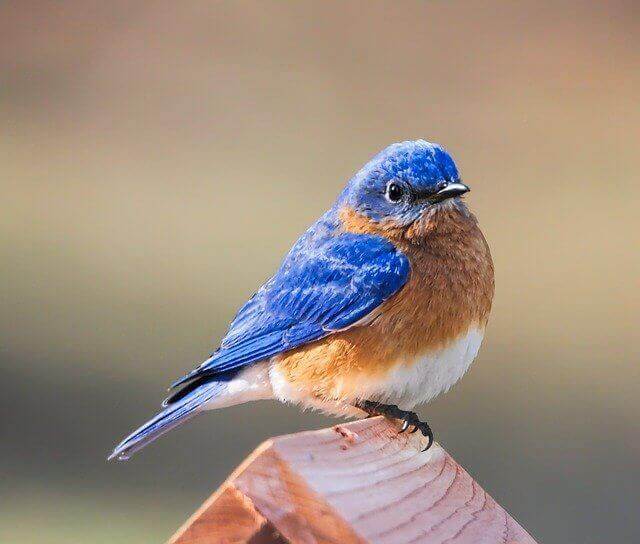
The eastern bluebird, is a common songbird in the United States and Canada. While the Eastern Bluebird is invasive species, they do make excellent additions to any garden in the right circumstances. They will add a beautiful touch of color, along with providing some shelter and protection from predators.
With their small size, eastern bluebirds do require slightly bigger habitat than other members of their genus. In the wild, they prefer to spend their time in large trees or in tall grasses. They will eat whatever food source they find but are very choosy about the type of food they eat.
If you don’t want to provide live food for them, you should purchase freeze dried mixes or bird seed. Both contain the right blend of nutrients for these active, flighty birds.
- Frequency: 21.67%
- Color: Has a blue head, back, and wings. reddish-brown breast
- Habitat: Open woodlands, farmlands, and orchards.
- Range: Southern Canada to the Gulf states, East of the Rockies and south to Arizona to Nicaragua
- Size: 5.5 – 7.1″ inches in length
- Weight: 20 – 33 grams
- Diet: insects and other invertebrates
- Family: Turdidae
- Genus: Sialia
Eastern Towhee
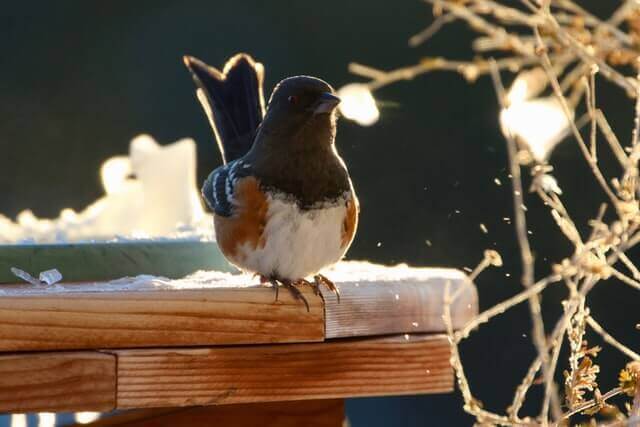
If you are a birder who is looking for a rare bird that only goes westward for the winter, then the eastern Towhee may be the bird for you. Eastern Towhee is common in wooded areas, as well as fields and meadows. They like a variety of habitats, including leaf litter, fields, roadsides, and forests. Foraging often occurs on lawns and may be visible to the unaided eye during the fall mating season.
Breeding between Eastern Towhee populations is very easy because they tend to be close enough together for good birdwatching. The male birds often nest near nesting places where females lay eggs. This ensures that the young aren’t far from danger while they are growing. The best time to watch these birds is in the morning when the air is cool and there is no dew. You can also find Eastern Towhee birds on road sides, near farms, or around bird feeders.
Typically, the Eastern Towhee will deposit the clutch of eggs into a bush in the shade, allowing the mother to feed her offspring while they learn to fly and find food. When the baby birds learn to fly, they will return to the nest to feed the youngsters and, after a few days, the Eastern Towhee will depart to find its own food.
- Frequency: 21.08%
- Color: Has a black head, upper body, and tail, reddish-brown sides, a white belly, and a long dark tail with white edges
- Habitat: Deciduous forests and thickets, roadside, grasslands, backyards, parks
- Range: Eastern USA and Canada
- Size: 6.8 – 9.1″ long
- Weight: 32 – 53 grams
- Diet: insects and other invertebrates occasionally small amphibians, snakes, and lizards
- Family: Passerellidae
- Genus: Pipilo
These backyard birds all have a frequency of less than 20% year-round
- House Sparrow – 20.00% Frequency
- White-throated Sparrow – 19.96%
- Northern Flicker – 17.44%
- Killdeer – 17.00%
- Brown-headed Cowbird 16.78%
- Indigo Bunting 16.58%
- Chipping Sparrow 14.52%
- Eastern Phoebe 13.97%
- Pileated Woodpecker 13.87%
- Field Sparrow 13.78%
- Dark-eyed Junco 13.44%
- Barn Swallow 12.43%
- Blue-gray Gnatcatcher 12.07%
- Chimney Swift 11.39%
- Brown Thrasher 11.19%
- Eastern Wood-Pewee 11.15%
- Eastern Meadowlark 11.00%
- Ruby-throated Hummingbird 10.77%
- Yellow-rumped Warbler 10.68%
- Belted Kingfisher 9.49%
- Red-eyed Vireo 9.41%
- Common Yellowthroat 9.29%
- Tree Swallow 9.25%
- Eastern Kingbird 8.41%
- Gray Catbird 8.36%
- American Kestrel 8.34%
- Hairy Woodpecker 7.35%
- Rock Pigeon 7.12%
- Cedar Waxwing 7.10%
- Northern Parula 7.10%
- White-eyed Vireo 6.87%
- Summer Tanager 6.81%
- Wood Thrush 6.22%
- Great Crested Flycatcher 6.18%
- Northern Rough-winged Swallow 6.00%
- Yellow-billed Cuckoo 5.66%
- House Wren 5.55%
- Red-headed Woodpecker 5.32%
Frequently Asked Questions
What is the biggest bird in Kentucky?
Broad-Winged Hawk is the biggest bird in Kentucky. It has a length that ranges from 13.8-17.7 inches (35-45 cm), a weight of 9.3-19.8 oz (263-562 g), and a wingspan of 31.5-40.2 inches (80-102 cm). The average lifespan of this bird is about 18 years in the wild and up to 23 years in captivity. Broad-Winged Hawk is a predator and feeds on small animals such as rodents, reptiles, and birds.
What kind of wrens are in Kentucky?
There are seven different types of wrens in Kentucky: the Carolina wren, house wren, winter wren, marsh wren, sedge wren, Bewick’s Wren, and rock wren. Each type of wren is unique in its own way, and all are interesting to watch and study.
Are golden eagles in Kentucky?
Golden eagles are very rare in Kentucky, and according to eBird they have less than a one percent frequency of occurrence in the state. They spend their winters in Kentucky, so they may be seen occasionally during that time. However, they are not commonly seen in the state.
Are there ravens in KY?
According to eBird very rare with less than 1 percent frequency of occurrence. While they can be found in many parts of the world, common ravens are not typically found in Kentucky. However, there have been a few reports of them being spotted in the state. Given their rarity, it is unlikely that you will see a common raven if you’re birdwatching in Kentucky.
What kind of falcons live in Kentucky?
There are two types of falcons that live in Kentucky: the Peregrine Falcon and the Prairie Falcon. The Peregrine Falcon is a large bird of prey with a hooked beak and powerful talons. They are fast flyers and can reach speeds of up to 200 miles per hour when diving for their prey. The Prairie Falcon is smaller than the Peregrine and has gray-brown plumage. They are also good flyers but not as fast as the Peregrine. Both types of falcons eat small birds and mammals, such as mice and squirrels.
Where can I see eagles in Kentucky?
There are a few places in Kentucky where you can see eagles. One good place to start is the Raven Run Nature Sanctuary. The 734 acre nature sanctuary is located in Lexington and is a great place to see a variety of wildlife, including eagles.
Where are eagles in Kentucky?
There are many places in Kentucky where you can find eagles. Some of the more popular spots include the Kentucky Dam, the Land Between the Lakes, and the Ohio River. Eagles can also be found in other parts of the state, but these are some of the more likely places to see them.


